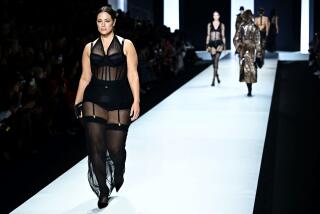Too thin to work? Fashion models should be benched if they’re underweight, health experts say

Fashion models show off the BCBG MAX AZRIA Spring 2016 collection during New York Fashion Week in September. Two health experts say models who are too thin should not be allowed to work in the U.S.
- Share via
Fashion models should be benched if they are dangerously thin, and U.S. regulators should make sure this happens.
So says a provocative editorial published Monday in the American Journal of Public Health.
The authors, both experts on eating disorders affiliated with the Harvard T.H. Chan School of Public Health in Boston, argue that fashion models are just as deserving of protection as coal miners and garment factory workers. Instead of being vulnerable to black lung or repetitive stress injuries, models are at risk of eating disorders like anorexia nervosa.
“The U.S. government regulates the extent to which any other industry can expose employees to harm,” write Katherine L. Record and S. Bryn Austin. “Professional fashion models are particularly vulnerable to eating disorders resulting from occupational demands to maintain extreme thinness.”
That’s hardly a trivial problem, they say: Anorexia is the deadliest of all mental illnesses in the U.S., claiming the lives of roughly 1 in 10 sufferers, according to Dr. Thomas Insel, director of the National Institute of Mental Health.
In the United States, a woman is considered underweight if her body mass index is below 18.5. But Record and Austin assert that a typical model strutting her stuff at an international fashion show has a BMI below 16, which the World Health Organization considers “severe thinness.” For a woman who is 5 feet 9 inches tall, that means weighing no more than 108 pounds.
For those who have any doubt that this can be deadly, consider the case of Brazilian model Ana Carolina Reston. She developed an eating disorder after being told she was too fat. Two years later, the 5-foot-8 model dropped down to 88 pounds by eating only apples and tomatoes. She died in 2006.
A ban on excessively thin fashion models may sound like doublespeak, but several countries have implemented them. The most notable is France, which passed a law in April that requires models to prove they have a BMI of at least 18 in order to work. If they fail to do so, their agents and fashion houses that hire them could be subject to steep fines and jail time.
There’s no good reason why the U.S. Occupational Safety and Health Administration (OSHA) couldn’t implement a similar policy here to prevent the “life-threatening starvation of runway models,” as Record (who works for the Massachusetts Health Policy Commission) and Austin (a researchers at Boston Children’s Hospital) put it. Recognizing that their proposal is likely to be met with skepticism, they address three likely criticisms in their editorial.
First, they acknowledge that BMI is “an imperfect measure of health.” But at the extreme ends of the weight spectrum, “the deficiencies associated with BMI as a metric dwindle,” they write.
Second, although fashion models are typically self-employed independent contractors – and thus not eligible for OSHA protection – Record and Austin argue that they’re effectively employees of their agents. As evidence, they note that “a model cannot negotiate or enter into any modeling opportunity without her agent, who retains exclusive rights to her name and image and determines and distributes her wages.” In fact, they add, regulating agents would be even more effective than regulating models.
Third, they take issue with the idea that the Americans with Disabilities Act would prevent any regulation linked to a person’s BMI. Setting a minimum threshold would be allowed “so long as it was implemented to protect employee health,” they say.
Not only is it possible for U.S. regulators to enforce a minimum BMI requirement for fashion models, it is necessary for them to do so, according to the editorial.
“Paired with similar restrictions in France, OSHA regulations in the United States would shake the fashion industry,” Record and Austin write. “Designers would be hard pressed to maintain a presence in the fashion industry without participating in the New York City and Paris Fashion Weeks.”
Follow me on Twitter @LATkarenkaplan and “like” Los Angeles Times Science & Health on Facebook.







